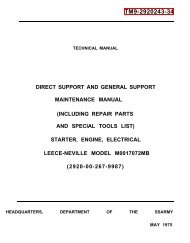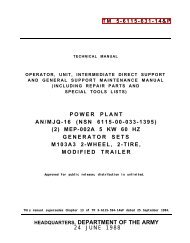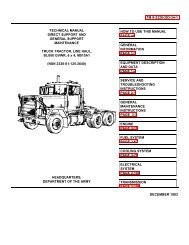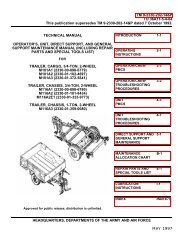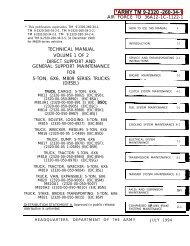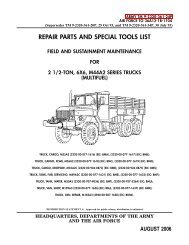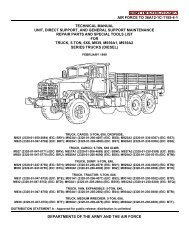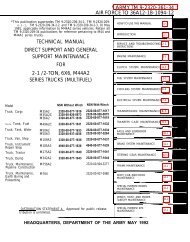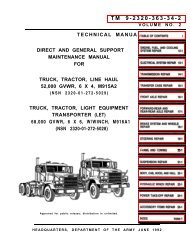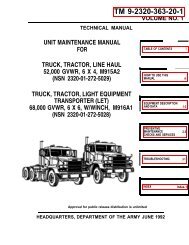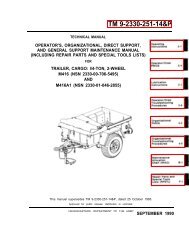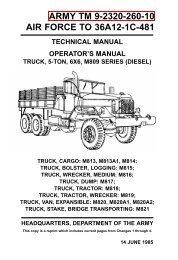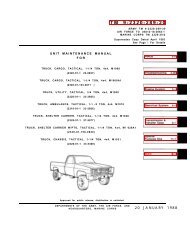- Page 1: TM 9-2320-211-10-1 T.O. 36A12-1C-42
- Page 5 and 6: *TM 2320-211-10-1 TO 36A12-1C-421-1
- Page 7 and 8: TM 9-2320-211-10-1 Paragraph Page S
- Page 9 and 10: TM 9-2320-211-10-1 Section II — C
- Page 11 and 12: TM 9-2320-211-10-1 APPENDIX A — C
- Page 13 and 14: TM 9-2320-211-10-1 LIST OF ILLUSTRA
- Page 15 and 16: TM 9-2320-211-10-1 CHAPTER 1 INTROD
- Page 17 and 18: TM 9-2320-211-10-1 b. For more info
- Page 19 and 20: TM 9-2320-211-10-1 TA 081043 Figure
- Page 21 and 22: TM 9-2320-211-10-1 CHAPTER 2 DESCRI
- Page 23 and 24: TM 9-2320-211-10-1 Figure 2-1. Over
- Page 25 and 26: TM 9-2320-211-10-1 TA 081047 1. Int
- Page 27 and 28: TM 9-2320-211-10-1 c. Electrical Sy
- Page 29 and 30: TM 9-2320-211-10-1 e. Cooling Syste
- Page 31 and 32: TM 9-2320-211-10-1 (2) Vertical exh
- Page 33 and 34: TM 9-2320-211-10-1 k. Propeller and
- Page 35 and 36: TM 9-2320-211-10-1 1. 2. 3. 4. 5. 6
- Page 37 and 38: TM 9-2320-211-10-1 m. Brake System.
- Page 39 and 40: TM 9-2320-211-10-1 (3) The compress
- Page 41 and 42: TM 9-2320-211-10-1 n. Axles, Wheels
- Page 43 and 44: TM 9-2320-211-10-1 Table 2-1. Weigh
- Page 45 and 46: TM 9-2320-211-10-1 Table 2-6. Permi
- Page 47 and 48: TM 9-2320-211-10-1 Table 2-7. Perfo
- Page 49 and 50: TM 9-2320-211-10-1 CHAPTER 3 SERVIC
- Page 51 and 52: TM 9-2320-211-10-1 CHAPTER 4 OPERAT
- Page 53 and 54:
TM 9-2320-211-10-1 a. Instrument Pa
- Page 55 and 56:
TM 9-2320-211-10-1 a. Instrument pa
- Page 57 and 58:
TM 9-2320-211-10-1 b. Windshield. 1
- Page 59 and 60:
TM 9-2320-211-10-1 c. Driver’s Co
- Page 61 and 62:
TM 9-2320-211-10-1 c. Driver’s Co
- Page 63 and 64:
TM 9-2320-211-10-1 c. Driver’s Co
- Page 65 and 66:
TM 9-2320-211-10-1 e. Trailer Brake
- Page 67 and 68:
TM 9-2320-211-10-1 a. Tractor Truck
- Page 69 and 70:
TM 9-2320-211-10-1 c. Wrecker Truck
- Page 71 and 72:
TM 9-2320-211-10-1 4-4. SPECIAL KIT
- Page 73 and 74:
TM 9-2320-211-10-1 b. Fuel Burning
- Page 75 and 76:
TM 9-2320-211-10-1 c. Powerplant He
- Page 77 and 78:
TM 9-2320-211-10-1 c. Powerplant He
- Page 79 and 80:
TM 9-2320-211-10-1 e. Electric Brak
- Page 81 and 82:
TM 9-2320-211-10-1 a. Before Engine
- Page 83 and 84:
TM 9-2320-211-10-1 1. On trucks wit
- Page 85 and 86:
TM 9-2320-211-10-1 FRAME 5 I 1. On
- Page 87 and 88:
TM 9-2320-211-10-1 b. Starting the
- Page 89 and 90:
TM 9-2320-211-10-1 FRAME 3 CAUTION
- Page 91 and 92:
TM 9-2320-211-10-1 FRAME 5 I WARNIN
- Page 93 and 94:
I TM 9-2320-211-10-1 c. Cold Weathe
- Page 95 and 96:
TM 9-2320-211-10-1 d. Placing and K
- Page 97 and 98:
TM 9-2320-211-10-1 Table 4-1. Vehic
- Page 99 and 100:
TM 9-2320-211-10-1 FRAME 3 1. To mo
- Page 101 and 102:
TM 9-2320-211-10-1 FRAME 5 I 1. To
- Page 103 and 104:
TM 9-2320-211-10-1 FRAME 7 1. To sh
- Page 105 and 106:
TM 9-2320-211-10-1 FRAME 9 I CAUTIO
- Page 107 and 108:
TM 9-2320-211-10-1 1. Trucks covere
- Page 109 and 110:
TM 9-2320-211-10-1 1. When the truc
- Page 111 and 112:
TM 9-2320-211-10-1 FRAME 4 CAUTION
- Page 113 and 114:
TM 9-2320-211-10-1 4-7. OPERATION O
- Page 115 and 116:
TM 9-2320-211-10-1 c. Unwinding the
- Page 117 and 118:
TM 9-2320-211-10-1 FRAME 3 I 1. Pul
- Page 119 and 120:
TM 9-2320-211-10-1 FRAME 5 I I WARN
- Page 121 and 122:
TM 9-2320-211-10-1 FRAME 7 I 1. GO
- Page 123 and 124:
TM 9-2320-211-10-1 FRAME 9 I 1. To
- Page 125 and 126:
TM 9-2320-211-10-1 FRAME 2 I CAUTIO
- Page 127 and 128:
TM 9-2320-211-10-1 FRAME 4 I 1. 2.
- Page 129 and 130:
TM 9-2320-211-10-1 f. Releasing the
- Page 131 and 132:
TM 9-2320-211-10-1 g. Winding Winch
- Page 133 and 134:
TM 9-2320-211-10-1 FRAME 3 I 1. On
- Page 135 and 136:
TM 9-2320-211-10-1 FRAME 5 1. 2. 3.
- Page 137 and 138:
TM 9-2320-211-10-1 T FRAME 2 1. For
- Page 139 and 140:
TM 9-2320-211-10-1 FRAME 4 1. On du
- Page 141 and 142:
TM 9-2320-211-10-1 4-8. OPERATION O
- Page 143 and 144:
TM 9-2320-211-10-1 FRAME 3 1. On M5
- Page 145 and 146:
TM 9-2320-211-10-1 c. Installing Fr
- Page 147 and 148:
TM 9-2320-211-10-1 FRAME 3 1. M54A2
- Page 149 and 150:
TM 9-2320-211-10-1 d. Removal of Fr
- Page 151 and 152:
TM 9-2320-211-10-1 FRAME 3 1. If tr
- Page 153 and 154:
TM 9-2320-211-10-1 FRAME 5 1. 2. 3.
- Page 155 and 156:
TM 9-2320-211-10-1 e. Installing Fr
- Page 157 and 158:
TM 9-2320-211-10-1 1. Lift tailgate
- Page 159 and 160:
TM 9-2320-211-10-1 FRAME 5 1. Pull
- Page 161 and 162:
TM 9-2320-211-10-1 PERSONNEL: TWO F
- Page 163 and 164:
TM 9-2320-211-10-1 g. Raising Drops
- Page 165 and 166:
TM 9-2320-211-10-1 h. Removing Drop
- Page 167 and 168:
TM 9-2320-211-10-1 i. Installing Dr
- Page 169 and 170:
TM 9-2320-211-10-1 4-9, OPERATION O
- Page 171 and 172:
TM 9-2320-211-10-1 1. Turn locking
- Page 173 and 174:
TM 9-2320-211-10-1 1. Turn tractor
- Page 175 and 176:
TM 9-2320-211-10-1 FRAME 7 I 1. Tur
- Page 177 and 178:
TM 9-2320-211-10-1 FRAME 9 1. Check
- Page 179 and 180:
TM 9-2320-211-10-1 FRAME 11 1. Take
- Page 181 and 182:
TM 9-2320-211-10-1 Soldier A Soldie
- Page 183 and 184:
TM 9-2320-211-10-1 c. Uncoupling Se
- Page 185 and 186:
TM 9-2320-211-10-1 FRAME 3 1. 2. 3.
- Page 187 and 188:
TM 9-2320-211-10-1 FRAME 5 I 1. Pus
- Page 189 and 190:
TM 9-2320-211-10-1 4-10. OPERATION
- Page 191 and 192:
TM 9-2320-211-10-1 c. Riggin g the
- Page 193 and 194:
TM 9-2320-211-10-1 . Rigging the Ta
- Page 195 and 196:
TM 9-2320-211-10-1 g. Unloading the
- Page 197 and 198:
TM 9-2320-211-10-1 1. 2. 3. 4. 5. 6
- Page 199 and 200:
TM 9-2320-211-10-1 FRAME 5 I 1. Aft
- Page 201 and 202:
TM 9-2320-211-10-1 FRAME 2 1. Turn
- Page 203 and 204:
TM 9-2320-211-10-1 FRAME 4 1. 2. 3.
- Page 205 and 206:
TM 9-2320-211-10-1 j. Unloading the
- Page 207 and 208:
TM 9-2320-211-10-1 FRAME 3 1. 2. 3.
- Page 209 and 210:
TM 9-2320-211-10-1 FRAME 5 I 1. Aft
- Page 211 and 212:
TM 9-2320-211-10-1 1. Lowering the
- Page 213 and 214:
TM 9-2320-211-10-1 n. Changing Tail
- Page 215 and 216:
TM 9-2320-211-10-1 c. Unwinding the
- Page 217 and 218:
TM 9-2320-211-10-1 FRAME 3 1. 2. 3.
- Page 219 and 220:
TM 9-2320-211-10-1 d. Rigging the W
- Page 221 and 222:
TM 9-2320-211-10-1 (3) For heavy lo
- Page 223 and 224:
TM 9-2320-211-10-1 f. Releasing the
- Page 225 and 226:
TM 9-2320-211-10-1 g. Securing for
- Page 227 and 228:
TM 9-2320-211-10-1 FRAME 3 1. Twist
- Page 229 and 230:
TM 9-2320-211-10-1 4-12. M543A2 MED
- Page 231 and 232:
TM 9-2320-211-10-1 FRAME 2 I 1. Ste
- Page 233 and 234:
TM 9-2320-211-10-1 RAME 4 Positioni
- Page 235 and 236:
TM 9-2320-211-10-1 FRAME 6 I 1. 2.
- Page 237 and 238:
TM 9-2320-211-10-1 Pull BOOM contro
- Page 239 and 240:
TM 9-2320-211-10-1 c. Lifting and S
- Page 241 and 242:
TM 9-2320-211-10-1 FRAME 3 1. 2. To
- Page 243 and 244:
TM 9-2320-211-10-1 FRAME 2 1. Chang
- Page 245 and 246:
TM 9-2320-211-10-1 FRAME 4 1. 2. To
- Page 247 and 248:
TM 9-2320-211-10-1 f. Rigging Crane
- Page 249 and 250:
TM 9-2320-211-10-1 g. Making Fast f
- Page 251 and 252:
TM 9-2320-211-10-1 FRAME 3 1. To ma
- Page 253 and 254:
TM 9-2320-211-10-1 FRAME 5 1. 2. 3.
- Page 255 and 256:
TM 9-2320-211-10-1 1. To make outri
- Page 257 and 258:
TM 9-2320-211-10-1 1. Take out pins
- Page 259 and 260:
TM 9-2320-211-10-1 j. Making Fast f
- Page 261 and 262:
TM 9-2320-211-10-1 4-14. OPERATION
- Page 263 and 264:
TM 9-2320-211-10-1 d. Operation of
- Page 265 and 266:
TM 9-2320-211-10-1 FRAME 3 CAUTION
- Page 267 and 268:
TM 9-2320-211-10-1 FRAME 2 1. Turn
- Page 269 and 270:
TM 9-2320-211-10-1 FRAME 4 1. To st
- Page 271 and 272:
TM 9-2320-211-10-1 FRAME 2 1. Plug
- Page 273 and 274:
TM 9-2320-211-10-1 4-15. OPERATION
- Page 275 and 276:
TM 9-2320-211-10-1 FRAME 3 1. 2. 3.
- Page 277 and 278:
TM 9-2320-211-10-1 FRAME 5 1. From
- Page 279 and 280:
TM 9-2320-211-10-1 Section III. OPE
- Page 281 and 282:
TM 9-2320-211-10-1 e. Parking. (1)
- Page 283 and 284:
TM 9-2320-211-10-1 4-20. OPERATION
- Page 285 and 286:
TM 9-2320-211-10-1 (5) If one or mo
- Page 287 and 288:
TM 9-2320-211-10-1 FRAME 2 1. Start
- Page 289 and 290:
TM 9-2320-211-10-1 4-23. EMERGENCY
- Page 291 and 292:
TM 9-2320-211-10-1 FRAME 3 1. Pull
- Page 293 and 294:
TM 9-2320-211-10-1 c. Towing Truck
- Page 295 and 296:
TM 9-2320-211-10-1 FRAME 2 - Contin
- Page 297 and 298:
TM 9-2320-211-10-1 Soldier B 1. Sol
- Page 299 and 300:
TM 9-2320-211-10-1 FRAME 6 1. Using
- Page 301 and 302:
TM 9-2320-211-10-1 FRAME 8 1. 2. 3.
- Page 303 and 304:
TM 9-2320-211-10-1 FRAME 10 1. Take
- Page 305 and 306:
TM 9-2320-211-10-1 FRAME 2 Soldiers
- Page 307 and 308:
TM 9-2320-211-10-1 FRAME 4 1. When
- Page 309 and 310:
TM 9-2320-211-10-1 APPENDIX A REFER
- Page 311 and 312:
TM 9-2320-211-10-1 APPENDIX B COMPO
- Page 313 and 314:
TM 9-2320-211-10-1 B-4. ABBREVIATIO
- Page 315 and 316:
TM 9-2320-211-10-1 Section II. B-5
- Page 317 and 318:
TM 9-2320-211-10-1 Section III. B-7
- Page 319 and 320:
TM 9-2320-211-10-1 Section III. B-9
- Page 321 and 322:
TM 9-2320-211-10-1 Section III. B-1
- Page 323 and 324:
TM 9-2320-211-10-1 Section III. B-1
- Page 325:
TM 9-2320-211-10-1 Section III. B15
- Page 328 and 329:
TM 9-2320-211-10-1 Section II. ADDI
- Page 330 and 331:
TM 9-2320-211-10-1 Section II. ADDI
- Page 332 and 333:
TM 9-2320-211-10-1 Section II. ADDI
- Page 334 and 335:
TM 9-2320-211-10-1 Section II. ADDI
- Page 336 and 337:
TM 9-2320-211-10-1 Section II. ADDI
- Page 338 and 339:
TM 9-2320-211-10-1 Section II. EXPE
- Page 340 and 341:
TM 9-2320-211-10-1 Section II. EXPE
- Page 342 and 343:
TM 9-2320-211-10-1 Section II. EXPE
- Page 344 and 345:
TM 9-2320-211-10-1 INDEX - CONT Sub
- Page 346 and 347:
TM 9-2320-211-10-1 INDEX - CONT Sub
- Page 348 and 349:
TM 9-2320-211-10-1 INDEX - CONT Sub



